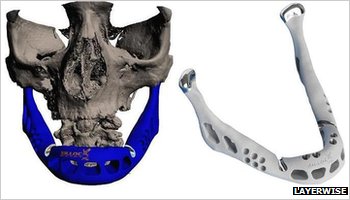Feb 07 2012
3D Printing
 This is one of those emerging technologies that has the potential to be a game changer – the ability to print three-dimensional objects. A recent news story brought to my attention how far this technology has come so far. Belgium surgeons have recently (this past June, although they just announced it) implanted an artificial jaw into an 83 year old woman. The jaw is made from titanium and was created with a 3-D printing process.
This is one of those emerging technologies that has the potential to be a game changer – the ability to print three-dimensional objects. A recent news story brought to my attention how far this technology has come so far. Belgium surgeons have recently (this past June, although they just announced it) implanted an artificial jaw into an 83 year old woman. The jaw is made from titanium and was created with a 3-D printing process.
The process of creating the jaw involved “printing” thin 2-D layers and then combining them:
“It used a laser beam to melt successive thin layers of titanium powder together to build the part.
“This was repeated with each cross section melted to the previous layer. It took 33 layers to build 1mm of height, so you can imagine there were many thousand layers necessary to build this jawbone.”
There are multiple advantages to this technology over other forms of crafting 3-D objects. Digital design is nothing new, but of course this process benefits from the ability to design a part with software, make it perfect, and then craft it. For surgically implantable parts this also allows for the use of CT scan or MRI scans to precisely design parts of the exactly correct size and shape. Using the layering process also allows for complex internal structure, like grooves and holes, that some methods cannot create.
There are many possible cool applications of this technology, beyond crafting surgical parts for implantation. The ability to create, modify, and store information digitally and then print that information on demand itself is a game changer. The publishing world is already feeling the effects of on-demand printing. We no longer have to print thousands of copies, store, and ship them, and therefore anticipate demand. Rather, we can print individual copies of books on demand, drastically reducing the overall cost and the need for infrastructure (like storage and distribution).
3-D printers bring this advantage to objects. A machine shop, for example, would not need to store lots of parts, or order them and have them shipped when needed. They could simply print each part on demand as needed. This is especially useful for rare or outdated parts. This would also make the creation of custom parts more practical. Custom shops can more easily, quickly, and precisely craft parts for cars or machines according to their own designs and needs.
In other words – the 3-D printer does for the creation of physical objects what digital media has already done for the creation of information (articles, books, music, and even art). It has dramatically lowered the barriers to creation and distribution.
If we extrapolate this trend (I know, this is always tricky) into the future, we are moving towards a world in which the creation of anything is limited only by ideas and information. There are no longer any editors that act as gatekeepers of creativity and information. Anyone can publish their thoughts, their videos or cartoons, online and distribute them to more people potentially than any previous publishing venue. This enables hidden talents without the resources to work their way up through a traditional publishing institution, or to get noticed by editors or producers, to put their creations into the public domain. This, of course, leads to a lot of crap, but there are also mechanisms in place to allow the cream to rise to the top.
That, of course, would be the ideal situation – a pure meritocracy of ideas and creativity. Give the tools of creation to everybody, and let ideas and products fight for attention in the common marketplace. There is still a role, I think, for experts to evaluate and promote exceptional creations. But it is better for this to be voluntary, rather than a barrier. Such mechanisms of expert evaluation have to compete themselves in the marketplace, to show their value and utility. Hopefully a new equilibrium will be reached between crowdsourcing and expert evaluation.
It will also be interesting to see how far the 3-D creation will go. Some futurists imagine a future in which we rarely, if ever, have to go out to purchase manufactured items, or even have them delivered. Rather, we print everything we need right at home. All we need is the raw material and the digital design, which we can alter at will. Of course, nanotechnology enthusiasts believe that ultimately it is nanotech that will fill this role, and there will be no such limits to on demand manufacturing. It is hard to say about what will be possible “eventually”, but such nanotech is still too far off to make any reasonable predictions, in my opinion.
Regardless, we have 3-D printing here now, and it is already practical not only for specialty use but for small businesses. It is not quite in the price range where most middle-class homes will have one, like a microwave. You can buy personal 3-D printers, but they still cost thousands of dollars. The Desktop Factory boasts that it has broken the 10k barrier. That is the barrier for small business and the rich, not for the average home. Traditionally the thousand dollar barrier is considered an important psychological barrier when such new technology products start to become widely used by consumers.
Wide consumer use appears to be in sight, however. It is possible that in 5-10 years or so we may ask ourselves, as with the microwave, how did we ever get by without our home 3-D printer.






